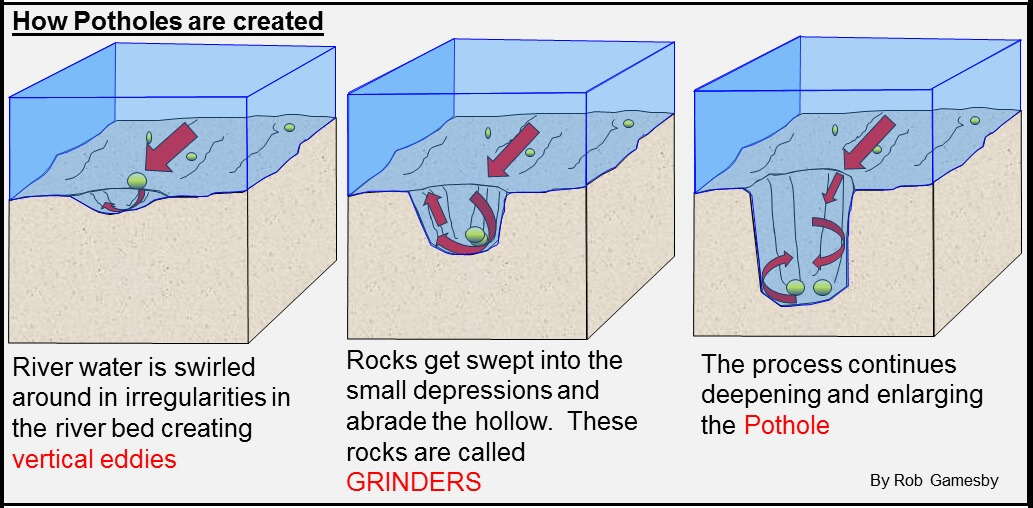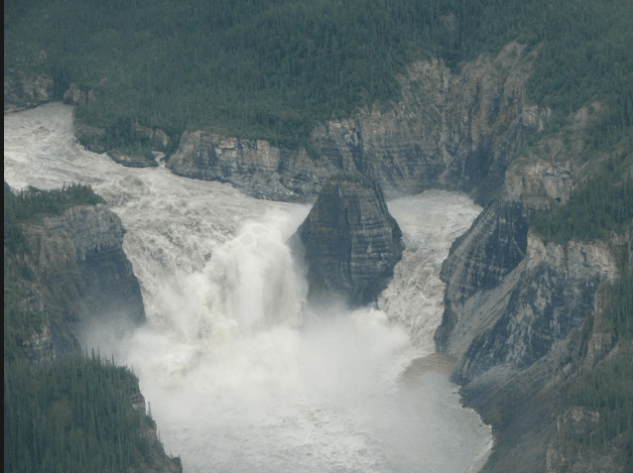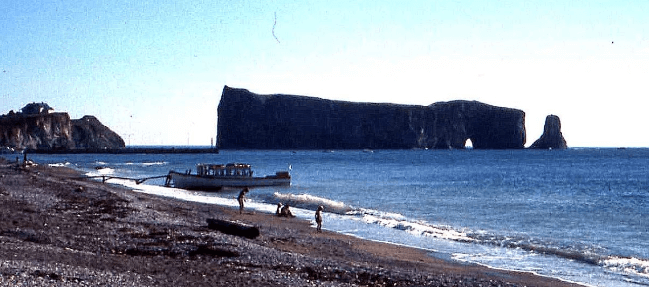Table of Contents
Forces Causing Erosion
It is plain that ever since the crust of the earth became stable enough to allow water to stand, waves to form, rain to fall, and weather to act, these forces have been working on the surface much as they are doing now. It is quite possible that in earlier ages they worked more actively. As a result of their action, the rocky heights of the earth have been continually worn down. This process is called erosion. To reach an explanation of the past, it will be useful for us to study carefully what is going on at the present.
Changes Caused by Running Water
 The effect of a single heavy shower gives the key. The running water carries the loose material down, spreads it out at a lower level, and sorts it more or less into coarse and fine, heavy and light. As the water moves the grains and pebbles, they grind one another smooth and round; the softer minerals are ground faster, so that the tendency is for them to be destroyed sooner and to be moved farther. This action provides for a further separation into deposits of different minerals, with the result that the harder and heavier minerals are collected in one place, the softer ones being ground up and deposited as mud, lower down. But running water, in the form of rivers, does more than move the loose stuff. Using the pebbles, etc. for scouring, it grinds its way down into the solid rock, and thus forms a valley with steep rocky banks, a canyon. These sides are later sloped off by other forces, to be discussed hereafter.
The effect of a single heavy shower gives the key. The running water carries the loose material down, spreads it out at a lower level, and sorts it more or less into coarse and fine, heavy and light. As the water moves the grains and pebbles, they grind one another smooth and round; the softer minerals are ground faster, so that the tendency is for them to be destroyed sooner and to be moved farther. This action provides for a further separation into deposits of different minerals, with the result that the harder and heavier minerals are collected in one place, the softer ones being ground up and deposited as mud, lower down. But running water, in the form of rivers, does more than move the loose stuff. Using the pebbles, etc. for scouring, it grinds its way down into the solid rock, and thus forms a valley with steep rocky banks, a canyon. These sides are later sloped off by other forces, to be discussed hereafter. 
Clear water has probably very little grinding and cutting effect, but its power to do this is very considerable when aided by the sand and gravel that the water carries along. The ability of moving water to transport solid masses increases very fast with its velocity. A rapid river carrying along pieces of rock of considerable size, grinds them on its rocky bed, and so cuts down its channel. Where the rock is too large to be moved along, or where it lodges in a hollow, it may be whirled around and around, grinding its way down into the rock; it is in this way, that potholes and kettles are formed, in rapids and falls. The potholes that are often seen where there is no running water now, must have been made at a time when the shape of the land was very different from its present condition. The rivers have changed their courses, owing to changes of level and to other causes.
Rapids and Waterfalls
Where a stream is flowing over the exposed edges of rock layers, if the upper layer is harder than the layers beneath, the latter wear away faster, and this tends to produce a rapid, which becomes steeper as the wearing goes on, until a waterfall is formed. A waterfall may also be caused by a break and a downward slip in a river valley, forming a precipice over which the water drops. In this case, a waterfall will gradually change into a rapid, if the surface rock is softer than that beneath. But if the harder layer is above, the waterfall wears its way back upstream without becoming a rapid, as in the case of Niagara Falls, which since the close of the last great glacial period has worn its way back the whole length of the gorge, about seven miles.
Natural Bridges
When the rock in the bed of a stream above a fall is cracked or jointed, the water has sometimes found its way down a crack and then along to the face of the cliff over which the stream falls. This underground channel has been gradually enlarged by the flow of water, until it was large enough to accommodate the whole stream, which then fell over the cliff at a lower level than formerly. The result of the wearing action of the stream has been to leave the rock above the underground channel as a natural bridge across the stream.
River Terraces
While the river is flowing down a steep valley, it carries its load of sand, gravel, and clay; but when it leaves the mountains and flows through flat country, it is unable to carry so much material; the excess is then deposited, and plains are built up. River terraces or benches are, in some cases, the remains of former flood plains, left by the river when it has cut its channel deeper. The finer material is carried on to deeper water, into a lake or the ocean, where it settles to the bottom.
Underground Rivers, Caves
Streams occasionally disappear and form underground rivers, which then wear down underground channels; it is in this way that some caves are formed. Most caves, however are caused by the dissolving action of water as it sinks through the rocks; the water enlarges the crevices by carrying away, in solution, calcite, gypsum, and others of the more easily soluble rock materials.
Leveling Effect
Rivers and other running water are thus constantly moving material from the higher parts of the land to the lower levels, finally depositing a great part of it in the ocean. The quantity thus transported is very large. It has been calculated that the Mississippi River and its tributaries are lowering the level of their whole drainage basin one foot in 9000 years, and are building up islands and shoals in the Gulf of Mexico at a corresponding rate.
Underground Water
A large part of the water that falls upon the surface of the earth sinks through the soil and subsoil, and finds its way downward through the crevices in the rocks. Some of it finds underground channels, through which it flows as distinct streams; but the greater part makes its way slowly through the pores and cracks. All rock contains more or less water moving in this way; but some rocks, like sandstone, are more porous than others, The greater part of the underground water finds its way to the surface as springs and seepage, which may also come out at the bottoms of lakes and rivers: and cases are known where streams of considerable size issue from the ground. Part of the water works its way downward until it meets with hot rock, and this later comes to the surface as geysers and hot springs, which are particularly numerous in the Yellowstone Park and in Iceland. But the dryness of some deep mines in their lower levels shows that the depth to which ground water penetrates is limited. The water of hot springs may come directly from the hot rock material.
The upper level of this ground water depends largely upon the rainfall. In countries with a heavy rainfall, the rocks and loose material are kept full of water to a relatively high level, marked in any district by the level to which water rises in wells, boreholes, and abandoned mine shafts; this level is called the water table. Locally, the water table may be influenced by the pressure created by underground water gathering in a porous rock that is overlain by a tight rock. If these rocks are lying at a slope, the pressure of the water at the lower levels of the slope will be greater than it is higher up; this is the explanation of flowing springs and artesian wells.
Erosion by Waves
The wearing action of waves upon the shores of lakes and seas is a matter of common observation. The building of breakwaters and other protecting structures is our recognition of the destructive force of the waves.
Storm waves hit the shore with a force of from a few hundred pounds to two or three tons on a square foot, varying with the violence of the storm. The force of the rushing water is great enough to move stones weighing as much as 100 tons. Waves striking a cliff have been known to dash up 200 feet, and it is said that the windows of Dunnett Light, Scotland, were once broken by stones carried up by a wave to a height of 300 feet.
When the shore consists of loose material, the waves have a comparatively easy task, washing out the smaller stuff, dislodging the larger pieces of rock, and in their retreat, moving the whole downwards.
Effects of Waves on Rocky Shores
Rocky shores are not so easily eroded; but the firmest rocks are attacked in ways not at first sight obvious. All rocks are more or less cracked; and these joints block out a rocky cliff into pieces, which the heavy blows of waves may break out. Stratified rocks are especially open to this attack of the waves, because the layers make up other lines of weakness. Both the joints and the planes between the layers are widened and deepened until some unusually strong wave dislodges a whole block. This result is aided by the hydraulic pressure of the waves working in the depths of the crevices. In cold countries, the blocks may be loosened by the action of frost; the cold freezes the water, which then expands and exerts an enormous pressure against the surfaces between which it is confined.
It is doubtful if the blow of water alone would have much effect upon hard rock, fairly free from open joints. But as the wave advances, it carries with it sand, gravel, and pebbles; even large stones are moved forward and used as battering rams. Waves armed with these materials make a formidable attack upon even, the hardest rocks. By these means the waves wear away the seacliffs, sometimes carving them into columns, chimneys, islets, and pierced rocks; or they may hollow them into sea caves, or undermine them until there is a fall of rock from above.

The material washed down from the shore or broken out of the sea cliff is kept in motion by the waves and the undertow (the flow downwards of the water which has moved up the shore in wave form). It is thus sorted into:
- (a) coarse material, which does not move down so far;
- (b) finer material, which is carried to greater depths;
- (c) the finest product (silt), which does not settle until it reaches depths ordinarily undisturbed.
The presence of this fine silt is sometimes shown by heavy storms, which cause the water to become muddy a long distance from shore.
 Resultant Effects of Wave Action
Resultant Effects of Wave Action
The waves are continually increasing the quantity of fine material by grinding the boulders, cobbles, pebbles, and grains of sand against one another, the effect being to round these pieces of rock and to reduce their size. Large pieces, not movable by the waves, may in this way be worked down to a manageable size. The total effect of the wave action is the gradual disappearance of the land into the sea. Part of the coast of Holland has been eaten into for about two miles within historic times. Whole villages have disappeared from the coast of England, and one of the most dangerous shoals on the east coast, the Goodwin Sands is the ruin of what was once a great English estate.
